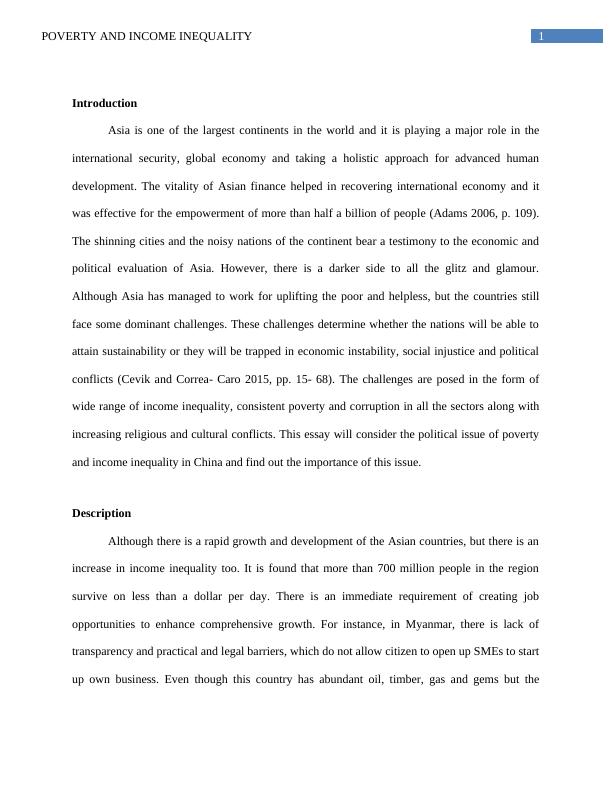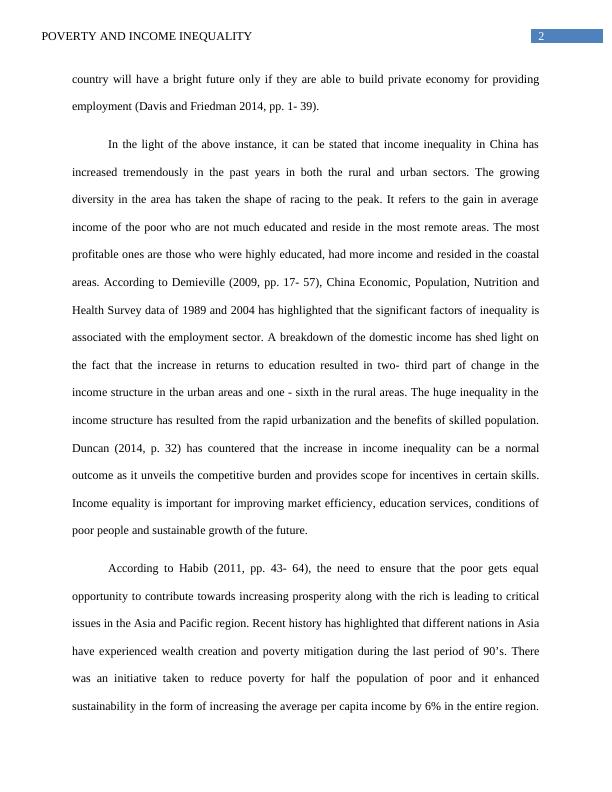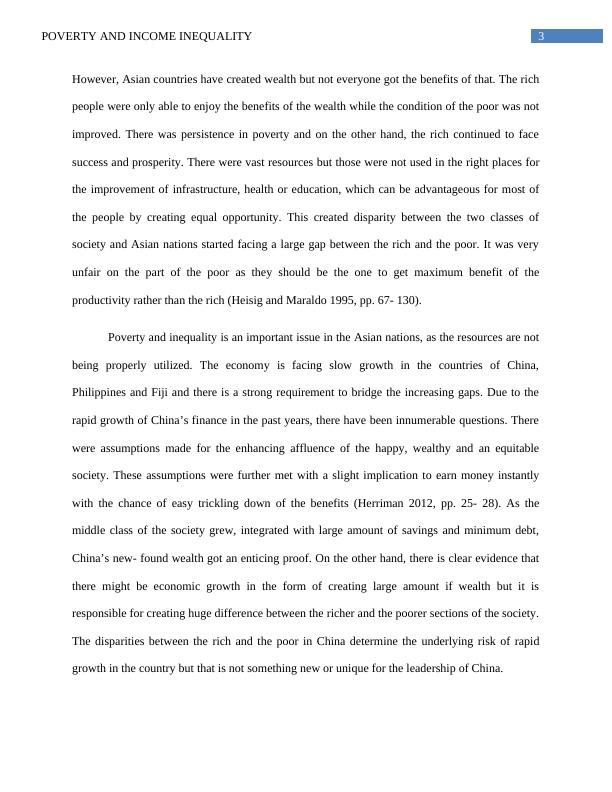Poverty and income inequality in China
11 Pages2830 Words243 Views
Added on 2023-06-11
About This Document
This essay discusses the issue of poverty and income inequality in China, highlighting the causes and effects of the problem. It also suggests ways to reduce poverty by working on the unequal distribution of wealth in China.
Poverty and income inequality in China
Added on 2023-06-11
ShareRelated Documents
Running head: POVERTY AND INCOME INEQUALITY
Poverty and income inequality in China
Name of the student:
Name of the university:
Author note
Poverty and income inequality in China
Name of the student:
Name of the university:
Author note

1POVERTY AND INCOME INEQUALITY
Introduction
Asia is one of the largest continents in the world and it is playing a major role in the
international security, global economy and taking a holistic approach for advanced human
development. The vitality of Asian finance helped in recovering international economy and it
was effective for the empowerment of more than half a billion of people (Adams 2006, p. 109).
The shinning cities and the noisy nations of the continent bear a testimony to the economic and
political evaluation of Asia. However, there is a darker side to all the glitz and glamour.
Although Asia has managed to work for uplifting the poor and helpless, but the countries still
face some dominant challenges. These challenges determine whether the nations will be able to
attain sustainability or they will be trapped in economic instability, social injustice and political
conflicts (Cevik and Correa- Caro 2015, pp. 15- 68). The challenges are posed in the form of
wide range of income inequality, consistent poverty and corruption in all the sectors along with
increasing religious and cultural conflicts. This essay will consider the political issue of poverty
and income inequality in China and find out the importance of this issue.
Description
Although there is a rapid growth and development of the Asian countries, but there is an
increase in income inequality too. It is found that more than 700 million people in the region
survive on less than a dollar per day. There is an immediate requirement of creating job
opportunities to enhance comprehensive growth. For instance, in Myanmar, there is lack of
transparency and practical and legal barriers, which do not allow citizen to open up SMEs to start
up own business. Even though this country has abundant oil, timber, gas and gems but the
Introduction
Asia is one of the largest continents in the world and it is playing a major role in the
international security, global economy and taking a holistic approach for advanced human
development. The vitality of Asian finance helped in recovering international economy and it
was effective for the empowerment of more than half a billion of people (Adams 2006, p. 109).
The shinning cities and the noisy nations of the continent bear a testimony to the economic and
political evaluation of Asia. However, there is a darker side to all the glitz and glamour.
Although Asia has managed to work for uplifting the poor and helpless, but the countries still
face some dominant challenges. These challenges determine whether the nations will be able to
attain sustainability or they will be trapped in economic instability, social injustice and political
conflicts (Cevik and Correa- Caro 2015, pp. 15- 68). The challenges are posed in the form of
wide range of income inequality, consistent poverty and corruption in all the sectors along with
increasing religious and cultural conflicts. This essay will consider the political issue of poverty
and income inequality in China and find out the importance of this issue.
Description
Although there is a rapid growth and development of the Asian countries, but there is an
increase in income inequality too. It is found that more than 700 million people in the region
survive on less than a dollar per day. There is an immediate requirement of creating job
opportunities to enhance comprehensive growth. For instance, in Myanmar, there is lack of
transparency and practical and legal barriers, which do not allow citizen to open up SMEs to start
up own business. Even though this country has abundant oil, timber, gas and gems but the

2POVERTY AND INCOME INEQUALITY
country will have a bright future only if they are able to build private economy for providing
employment (Davis and Friedman 2014, pp. 1- 39).
In the light of the above instance, it can be stated that income inequality in China has
increased tremendously in the past years in both the rural and urban sectors. The growing
diversity in the area has taken the shape of racing to the peak. It refers to the gain in average
income of the poor who are not much educated and reside in the most remote areas. The most
profitable ones are those who were highly educated, had more income and resided in the coastal
areas. According to Demieville (2009, pp. 17- 57), China Economic, Population, Nutrition and
Health Survey data of 1989 and 2004 has highlighted that the significant factors of inequality is
associated with the employment sector. A breakdown of the domestic income has shed light on
the fact that the increase in returns to education resulted in two- third part of change in the
income structure in the urban areas and one - sixth in the rural areas. The huge inequality in the
income structure has resulted from the rapid urbanization and the benefits of skilled population.
Duncan (2014, p. 32) has countered that the increase in income inequality can be a normal
outcome as it unveils the competitive burden and provides scope for incentives in certain skills.
Income equality is important for improving market efficiency, education services, conditions of
poor people and sustainable growth of the future.
According to Habib (2011, pp. 43- 64), the need to ensure that the poor gets equal
opportunity to contribute towards increasing prosperity along with the rich is leading to critical
issues in the Asia and Pacific region. Recent history has highlighted that different nations in Asia
have experienced wealth creation and poverty mitigation during the last period of 90’s. There
was an initiative taken to reduce poverty for half the population of poor and it enhanced
sustainability in the form of increasing the average per capita income by 6% in the entire region.
country will have a bright future only if they are able to build private economy for providing
employment (Davis and Friedman 2014, pp. 1- 39).
In the light of the above instance, it can be stated that income inequality in China has
increased tremendously in the past years in both the rural and urban sectors. The growing
diversity in the area has taken the shape of racing to the peak. It refers to the gain in average
income of the poor who are not much educated and reside in the most remote areas. The most
profitable ones are those who were highly educated, had more income and resided in the coastal
areas. According to Demieville (2009, pp. 17- 57), China Economic, Population, Nutrition and
Health Survey data of 1989 and 2004 has highlighted that the significant factors of inequality is
associated with the employment sector. A breakdown of the domestic income has shed light on
the fact that the increase in returns to education resulted in two- third part of change in the
income structure in the urban areas and one - sixth in the rural areas. The huge inequality in the
income structure has resulted from the rapid urbanization and the benefits of skilled population.
Duncan (2014, p. 32) has countered that the increase in income inequality can be a normal
outcome as it unveils the competitive burden and provides scope for incentives in certain skills.
Income equality is important for improving market efficiency, education services, conditions of
poor people and sustainable growth of the future.
According to Habib (2011, pp. 43- 64), the need to ensure that the poor gets equal
opportunity to contribute towards increasing prosperity along with the rich is leading to critical
issues in the Asia and Pacific region. Recent history has highlighted that different nations in Asia
have experienced wealth creation and poverty mitigation during the last period of 90’s. There
was an initiative taken to reduce poverty for half the population of poor and it enhanced
sustainability in the form of increasing the average per capita income by 6% in the entire region.

3POVERTY AND INCOME INEQUALITY
However, Asian countries have created wealth but not everyone got the benefits of that. The rich
people were only able to enjoy the benefits of the wealth while the condition of the poor was not
improved. There was persistence in poverty and on the other hand, the rich continued to face
success and prosperity. There were vast resources but those were not used in the right places for
the improvement of infrastructure, health or education, which can be advantageous for most of
the people by creating equal opportunity. This created disparity between the two classes of
society and Asian nations started facing a large gap between the rich and the poor. It was very
unfair on the part of the poor as they should be the one to get maximum benefit of the
productivity rather than the rich (Heisig and Maraldo 1995, pp. 67- 130).
Poverty and inequality is an important issue in the Asian nations, as the resources are not
being properly utilized. The economy is facing slow growth in the countries of China,
Philippines and Fiji and there is a strong requirement to bridge the increasing gaps. Due to the
rapid growth of China’s finance in the past years, there have been innumerable questions. There
were assumptions made for the enhancing affluence of the happy, wealthy and an equitable
society. These assumptions were further met with a slight implication to earn money instantly
with the chance of easy trickling down of the benefits (Herriman 2012, pp. 25- 28). As the
middle class of the society grew, integrated with large amount of savings and minimum debt,
China’s new- found wealth got an enticing proof. On the other hand, there is clear evidence that
there might be economic growth in the form of creating large amount if wealth but it is
responsible for creating huge difference between the richer and the poorer sections of the society.
The disparities between the rich and the poor in China determine the underlying risk of rapid
growth in the country but that is not something new or unique for the leadership of China.
However, Asian countries have created wealth but not everyone got the benefits of that. The rich
people were only able to enjoy the benefits of the wealth while the condition of the poor was not
improved. There was persistence in poverty and on the other hand, the rich continued to face
success and prosperity. There were vast resources but those were not used in the right places for
the improvement of infrastructure, health or education, which can be advantageous for most of
the people by creating equal opportunity. This created disparity between the two classes of
society and Asian nations started facing a large gap between the rich and the poor. It was very
unfair on the part of the poor as they should be the one to get maximum benefit of the
productivity rather than the rich (Heisig and Maraldo 1995, pp. 67- 130).
Poverty and inequality is an important issue in the Asian nations, as the resources are not
being properly utilized. The economy is facing slow growth in the countries of China,
Philippines and Fiji and there is a strong requirement to bridge the increasing gaps. Due to the
rapid growth of China’s finance in the past years, there have been innumerable questions. There
were assumptions made for the enhancing affluence of the happy, wealthy and an equitable
society. These assumptions were further met with a slight implication to earn money instantly
with the chance of easy trickling down of the benefits (Herriman 2012, pp. 25- 28). As the
middle class of the society grew, integrated with large amount of savings and minimum debt,
China’s new- found wealth got an enticing proof. On the other hand, there is clear evidence that
there might be economic growth in the form of creating large amount if wealth but it is
responsible for creating huge difference between the richer and the poorer sections of the society.
The disparities between the rich and the poor in China determine the underlying risk of rapid
growth in the country but that is not something new or unique for the leadership of China.

End of preview
Want to access all the pages? Upload your documents or become a member.
Related Documents
Poverty in China: Analysis, Solutions and Challengeslg...
|10
|2261
|229
Assignment on Contemporary Chinas Governmentlg...
|8
|2925
|32
Ways to Define and Measure Inequalitylg...
|3
|580
|74
Development of Tourism Sector in Eastern Asialg...
|5
|889
|458
Perspectives on Social Inequalitylg...
|6
|1749
|252
South Asia and the World: Rapid Increase of South Asia as an Economic Powerlg...
|6
|1342
|372
